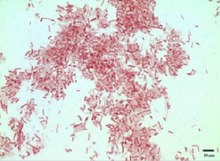Photorhabdus luminescens
| Photorhabdus luminescens | |
|---|---|

| |
| Scientific classification | |
| Domain: | Bacteria |
| Phylum: | Pseudomonadota |
| Class: | Gammaproteobacteria |
| Order: | Enterobacterales |
| Family: | Morganellaceae |
| Genus: | Photorhabdus |
| Species: | P. luminescens
|
| Binomial name | |
| Photorhabdus luminescens | |
| Synonyms | |
|
Xenorhabdus luminescens | |
Photorhabdus luminescens (previously called Xenorhabdus luminescens) is a Gammaproteobacterium of the family Morganellaceae, and is a lethal pathogen of insects.
It lives in the gut of an entomopathogenic nematode of the family Heterorhabditidae. When the nematode infects an insect, P. luminescens is released into the blood stream and rapidly kills the insect host (within 48 hours) by producing toxins, such as the high molecular weight insecticidal protein complex Tca.[2] P. luminescens also produces a proteic toxin through the expression of a single gene called makes caterpillars floppy (mcf).[3]
It also secretes enzymes which break down the body of the infected insect and bioconvert it into nutrients which can be used by both nematode and bacteria. In this way, both organisms gain enough nutrients to replicate (or reproduce in the case of the nematode) several times. The bacteria enter the nematode progeny as they develop.
3,5-Dihydroxy-4-isopropyl-trans-stilbene is produced by P. luminescens bacterial symbiont of the nematode Heterorhabditis megidis. Experiments with Galleria mellonella infected larvae supports the hypothesis that the compound has antibiotic properties that help minimize competition from other microorganisms and prevents the putrefaction of the nematode-infected insect cadaver.[4]
P. luminescens is bioluminescent; however, the reason for this is not yet properly understood.
It has been reported that infection by this bacterium of the wounds of soldiers in the American Civil War at the Battle of Shiloh caused the wounds to glow, and that this aided the survival of the soldiers due to the production of antibiotics by P. luminescens.[5][6] This led to the phenomenon's nickname "Angel's Glow."[7]
There are no contemporary accounts of this phenomenon, meaning that it may be a myth or that conditions including low temperatures, low lighting, abundance of blood, time on battlefield, presence of specific vegetation, presence of rain and humidity, and the time to organize medical evacuation would prevent the phenomenon from recurring in current conditions.[8][9]
P. luminescens' genome has been sequenced. It contains a MACPF protein, however, this molecule appears non-lytic.[10] It also contains the gcvB RNA gene which encodes a small non-coding RNA involved in the regulation of a number of amino acid transport systems as well as amino acid biosynthetic genes.
A deletion of the hfq gene causes loss of secondary metabolite production.[11]
It is a source for bioluminescence imaging.
See also
- Pseudomonas protegens, another insect pathogenic bacterium
References
- ^ Boemare, N. E.; Akhurst, R. J.; Mourant, R. G. (1993). "DNA Relatedness between Xenorhabdus spp. (Enterobacteriaceae), Symbiotic Bacteria of Entomopathogenic Nematodes, and a Proposal to Transfer Xenorhabdus luminescens to a New Genus, Photorhabdus gen. Nov". International Journal of Systematic Bacteriology. 43 (2): 249. doi:10.1099/00207713-43-2-249.
- ^ Blackburn, MB; Domek, JM; Gelman, DB; Hu, JS (2005). "The broadly insecticidal Photorhabdus luminescens toxin complex a (Tca): Activity against the Colorado potato beetle, Leptinotarsa decemlineata, and sweet potato whitefly, Bemisia tabaci". Journal of Insect Science. 5: 32. doi:10.1093/jis/5.1.32. PMC 1615239. PMID 17119614. Archived from the original on 2013-12-02. Retrieved 2016-11-11.
- ^ Daborn, P. J.; Waterfield, N.; Silva, C. P.; Au, C. P. Y.; Sharma, S.; Ffrench-Constant, R. H. (2002). "A single Photorhabdus gene, makes caterpillars floppy (mcf), allows Escherichia coli to persist within and kill insects". Proceedings of the National Academy of Sciences. 99 (16): 10742–10747. doi:10.1073/pnas.102068099. PMC 125031. PMID 12136122.
- ^ Hu, K; Webster, JM (2000). "Antibiotic production in relation to bacterial growth and nematode development in Photorhabdus--Heterorhabditis infected Galleria mellonella larvae". FEMS Microbiology Letters. 189 (2): 219–23. doi:10.1111/j.1574-6968.2000.tb09234.x. PMID 10930742.
- ^ Durham, Sharon (2001-05-29). "Students May Have Answer for Faster-Healing Civil War Wounds that Glowed". Agricultural Research Service.
- ^ Kwok, Roberta (21 January 2012). "New Scientist - 21 January 2012 -Driller Killer". New Scientist.
- ^ Soniak, Matt (2012-04-05). "Why Some Civil War Soldiers Glowed in the Dark". Mental Floss. Archived from the original on 2012-10-14.
- ^ "Photorhabdus luminescens: The Angel's Glow". The Naked Scientists. February 25, 2011. Retrieved May 2, 2022.
- ^ "Angel's Glow: From Civil War Folklore To Winning Science Fair Project". WBUR. August 21, 2020. Retrieved May 2, 2022.
- ^ Rosado CJ, Buckle AM, Law RH, et al. (2007). "A Common Fold Mediates Vertebrate Defense and Bacterial Attack". Science. 317 (5844): 1548–51. doi:10.1126/science.1144706. PMID 17717151. S2CID 20372720.
- ^ Tobias NJ, Heinrich AK, Eresmann H, Wright PR, Neubacher N, Backofen R, Bode HB (2016). "Photorhabdus-nematode symbiosis is dependent on hfq-mediated regulation of secondary metabolites". Environmental Microbiology. 19 (1): 119–129. doi:10.1111/1462-2920.13502. PMID 27555343. S2CID 6541706.
External links
- NCBI genome project Photorhabdus luminescens subsp. laumondii TTO1 project at Institut Pasteur
- MicrobeWiki - Photorhabdus luminescens at Kenyon College's Microbe Wiki
- Type strain of Photorhabdus luminescens at BacDive - the Bacterial Diversity Metadatabase